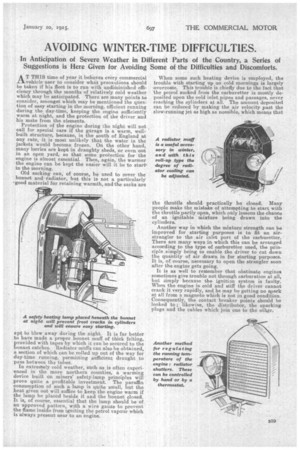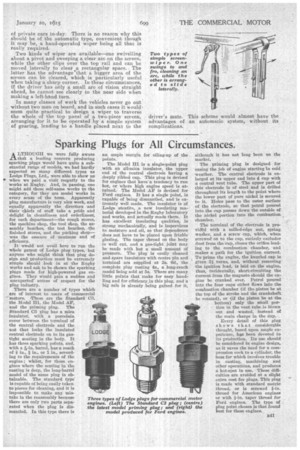AVOIDING WINTER-TIME DIFFICULTIES.
Page 23

Page 24

Page 25

If you've noticed an error in this article please click here to report it so we can fix it.
In Anticipation of Severe Weather in Different Parts of the Country, a Series of Suggestions is Here Given for Avoiding Some of the Difficulties and Discomforts.
AT THIS time of year it behoves every commercial vehicle user to consider what precautions should be taken if his fleet is to run with undiminished efficiency through the months of relatively cold weather which may be anticipated. There are many points to consider, amongst which may be mentioned the question of easy starting in the morning, efficient running during the day-time, keeping the engine sufficiently warm at night, and the protection of the driver and his mate from the elements.
Protection of the engine during the night will not call for special care if the garage is a warm, wellbuilt structure, because, in the south of England at any rate, it is most unlikely that the water in the jackets would become frozen. On the other hand, many lorries are kept in draughty sheds or even out in an open yard, so that some protection for the engine is almost essential. Then, again, the warmer the engine can be kept the easier will it be to start, in the morning.
OH sacking can, of course, be used to cover the bonnet andradiator, but this is not a particularly 'good material for retaining warmth, and the sacks are apt to blow away during the night. It is far better to have made a proper bonnet muff of thick felting, provided with tapes by which it can be secured to the bonnet catches. Radiator muffs can also be obtained, a section of which can be rolled up out of the way for day-time running, permitting sufficient draught to pass between the tubes.
In extremely cold weather, such as is often experi. enced in the more northern counties, a warming device built on miners' safety-lamp principles will prove quite a profitable investment. The paraffin consumption of such a lamp is quite small, but the heat given out will suffice to keep the engine warm if the lamp be placed beside it and the bonnet closed. It is, of course, essential that the lamp should be of an approved pattern, with a wire gauze to prevent the flame inside from Igniting the petrol vapour which is always present near to an engine.
When some such heating device is employed, the trouble with starting up on cold mornings is largely overcome. This trouble is chiefly due to the fact that the petrol sucked from the carburetter is mostly deposited upon the Gold inlet pipes and passages, never reaching the cylinders at all. The amount deposited can be reduced by making the air velocity past the slow-running jet as high as nossible, which means that the throttle should practically be closed. Many people make the mistake of attempting to start with the throttle partly open, which only lessens the chance of an ignitable mixture being drawn into the cylinders.
Another way in which the mixture strength can be improved for starting purposes is to fit an airstrangler to the air inlet port of the carburetter. There are many ways in which this can be arranged according to the type of carburetter used, the principle simply being to enable the driver to cut down the quantity of air drawn in for starting purposes. It is, of course, necessary to open the strangler soon after the engine gets going.
It. is as well to remember that obstinate engines sometimes give trouble not through carburation at all, 'hut simply because the ignition system is faulty. When the engine is cold and stiff the driver cannot crank it very rapidly, and he may be getting no spark at all from a magneto which is not in good condition. Consequently, the contact breaker points should be looked to ; likewise, the distributor, the sparking plugs and the cables which join one to the other. Engines with long induction .pipes are often particularly troublesome in cold weather, and where a lorry has had to be left out without any protection for many hours quite heroic expedients are sometimes called for to get a start. Injecting a little petrol through the compression taps is a well-known expedient, but better still is the special priming plug of the Lodge type, by means of which the petrol injected can be brought to the sparking points themselves.
Failing the provision of an air-strangler, it is often a good tap to stuff the air inlet with a piece of cotton waste soaked in petrol. A troublesome, but well-nigh infallible, iemedy is to pour boilng water over the induction pipe and carburetter.
After a. cold engine has been persuaded to start, a little care should be exercised in the way in which
it is warmed up. For example, it is not advisable to attempt to run it under full load straight away, because cold oil does not circulate freely and damage may be done to the bearings.
Many engines will not pull, or even fire regularly, for some time after starting, and in such cases an improvement can be made by leading a flexible metallic pipe from the air inlet on the carburetter to a muff placed against the exhaust pipe. The carburetter will. then be able to suck in air warmed by the exhaust. This plan can be elaborated with advantage by providing a series of ports next to the carburetter, opened and closed by a lever on the dash, so that when the engine is thoroughly warm the driver can open these ports and allow cold air to be sucked in direct.
As has already been pointed out in this journal, an automatic temperature control fitted to the circulating system will materially assist the engine to warm up. Alternatively, radiator ilintters controlled by hand constitute a practical fitment tor delivery vans which really enhance the appearance of the vehicles. The advent of wet and cold weather leads one to consider the degree of protection usually afforded to the driver and his mate. While considerable improvement Was been made in this respect of recent years, there can be no question that much remains" to be done. Quite apart from the physical comfort of the men involved—in, itself an important consideration—it should be realized that a driver who is cold and wt cannot possibly be expected to perform his dutirs efficiently over long periods, and is, therefore, a
_potential source of danger to his vehicle, his load-, and to other road users.
From this point of view the enclosed' type of driving cab is undoubtedly the right thing, and is becoming increasingly used The screen in front is usually made in three parts, the two upper panels_ being binged so that either can be opened at will. Sometimes this degree of protection is increased by providing sliding windows or screens fitted to the doors at each side, these serving to prevent rain or sleet from beating in sideways. A point to remember, when the driver is completely enclosed, is that a driving mirror becomes more than ever essential, and a flap, or sliding panel should be provided on the off-side side screen, so that the driver can extend a signalling arm.
In wet weather the driver is, of course, free to open his part of the windscreen so as to obtain an unobstructed view. It would really seem, however, that there is ground for the adoption of some simple form of windscreen wiper such as is fitted to the majority
of private cars to-day. There is no reason why this ,should be of the automatic type, convenient though it maybe, a hand-operated wiper being all that is really required.
Two kinds of wiper are available—one swivelling about a pivot and sweeping a clear arc on the screen, while the other clips over the top rail and can be moved laterally to clear a rectangular space. The latter has the advantage'that a bigg6r area of the screen can be cleared, which is 'particularly useful when taking a sharp corner. In these circumstances, if the driver has only a small arc of vision straight ahead, he cannot see clearly to the near side when making a left-hand turn.
In many classes of work the vehicles never go out -without two men on board, and in such cases it NV o ul +31 seem quite practical to design a wiper to traverse the whole of the top panel of a two-piece screen, arranging for it to be operated by a simple system of gearing, leading to a handle placed next to the






























